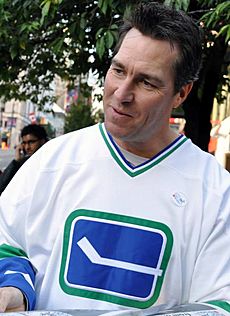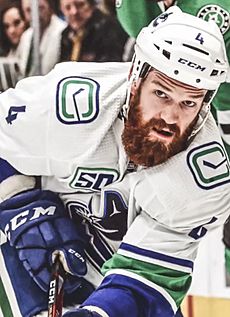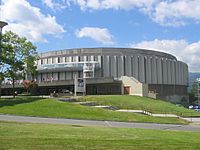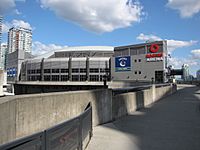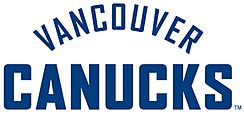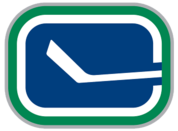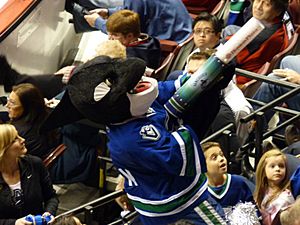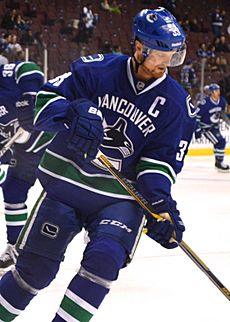Vancouver Canucks facts for kids
Quick facts for kids Vancouver Canucks |
|
|---|---|
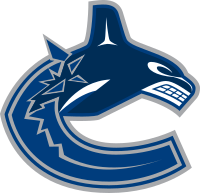 |
|
| Conference | Western |
| Division | Pacific |
| Founded | 1945 (PCHL) 1970 (as NHL expansion team) |
| History | Vancouver Canucks 1945–1952 (PCHL) Vancouver Canucks 1952–1970 (WHL) Vancouver Canucks 1970–present (NHL) |
| Home arena | Rogers Arena |
| City | Vancouver, British Columbia |
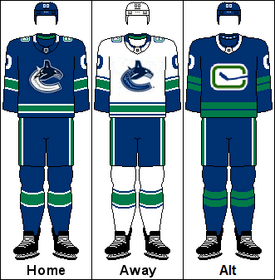 |
|
| Colours | Blue, green, white |
| Media | Sportsnet Pacific Sportsnet One Sportsnet 650 |
| Owner(s) | Canucks Sports & Entertainment (Francesco Aquilini, chairman) |
| General manager | Patrik Allvin |
| Head coach | Adam Foote |
| Captain | Quinn Hughes |
| Minor league affiliates | Abbotsford Canucks (AHL) Kalamazoo Wings (ECHL) |
| Stanley Cups | 0 |
| Conference championships | 3 (1981–82, 1993–94, 2010–11) |
| Presidents' Trophies | 2 (2010–11, 2011–12) |
| Division championships | 11 (1974–75, 1991–92, 1992–93, 2003–04, 2006–07, 2008–09, 2009–10, 2010–11, 2011–12, 2012–13, 2023–24) |
The Vancouver Canucks are a professional ice hockey team from Vancouver, British Columbia, Canada. They play in the National Hockey League (NHL) as part of the Pacific Division in the Western Conference. The team's home games are played at Rogers Arena. Adam Foote is the head coach, and Quinn Hughes is the team captain.
The Canucks joined the NHL in 1970 as a new team, along with the Buffalo Sabres. They have reached the Stanley Cup Final three times, but have not yet won the championship. They lost to the New York Islanders in 1982, the New York Rangers in 1994, and the Boston Bruins in 2011. The Canucks have won the Presidents' Trophy twice, which is given to the team with the best regular season record in the league. This happened in the 2010–11 and 2011–12 seasons. They have also won 11 division titles throughout their history.
The Canucks have honored six players by retiring their jersey numbers: Pavel Bure (10), Stan Smyl (12), Trevor Linden (16), Markus Naslund (19), Daniel Sedin (22), and Henrik Sedin (33).
Contents
Team History
Early Days and Joining the NHL
Before the NHL Canucks, Vancouver had other hockey teams. The first professional team was the Vancouver Millionaires, formed in 1911. They won the Stanley Cup in 1915, which was a big deal for a West Coast team. After them, Vancouver had minor league teams, including a team also called the Vancouver Canucks from 1945 to 1970.
Vancouver wanted an NHL team and built a new arena, the Pacific Coliseum, in 1966. A group from Vancouver tried to get an NHL team in 1967, but their request was turned down. Later, the NHL promised Vancouver a team in the next expansion round. In 1970, a new ownership group bought the existing WHL Canucks team and brought them into the NHL, along with the Buffalo Sabres.
To build their first NHL team, the Canucks picked players in an expansion draft. Their first captain was Orland Kurtenbach. The team played its first game on October 9, 1970, losing 3–1 to the Los Angeles Kings. Two days later, they got their first win against the Toronto Maple Leafs.
First Playoff Appearances
The Canucks had a tough start, missing the playoffs for their first four seasons. In the 1974–75 season, they had their first winning record and made the Stanley Cup playoffs for the first time. They finished first in their division but lost in the first round to the Montreal Canadiens. This was an important season because they were competing with another hockey team in Vancouver, the Vancouver Blazers, but the Canucks proved to be more popular.
The 1982 Stanley Cup Run
The Canucks made a surprising run to the Stanley Cup Final in 1982. Even though they had a losing record in the regular season, they played very well in the playoffs. During a game in Chicago, their coach, Roger Neilson, famously waved a white towel on a stick to show his frustration with the referees. This led to fans in Vancouver waving white towels to support the team, a tradition now known as "Towel Power" that is used by fans across many sports.
The Canucks reached the Stanley Cup Final for the first time, facing the strong New York Islanders, who had won the championship the previous two years. The Islanders were a much stronger team, and the Canucks lost the series in four games. Even though they didn't win, this playoff run was a memorable moment for the team and its fans.
Building a New Team (1987–1998)
After 1982, the Canucks struggled for several years. In 1987, Pat Quinn became the general manager and started to rebuild the team. He brought in new, younger players like goaltender Kirk McLean and winger Greg Adams. The team also drafted future stars like Trevor Linden in 1988 and Pavel Bure in 1989. Bure, known as "The Russian Rocket," became the team's first true superstar, scoring 60 goals in back-to-back seasons.
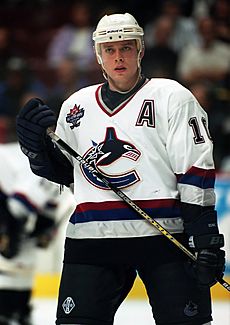
In the early 1990s, the Canucks became a strong team again, winning their division in 1992 and 1993.
The 1994 Stanley Cup Run
In 1994, the Canucks made another exciting run to the Stanley Cup Final. They started the playoffs as a lower-ranked team but surprised everyone. In the first round against the Calgary Flames, they came back from being down 3–1 in the series to win in seven games. The deciding game included two famous plays: a fantastic save by goaltender Kirk McLean and a breakaway goal by Pavel Bure in overtime.
The Canucks then defeated the Dallas Stars and Toronto Maple Leafs to reach the Final. They faced the New York Rangers, who were the best team in the league that year. The series was very close, going to a seventh and final game. Despite a great effort, the Canucks lost game seven by a score of 3–2. After the game, there were some disturbances in downtown Vancouver, but the fans later showed their support at a rally attended by 45,000 people.
After the 1994 run, the team moved to a new arena, General Motors Place (now Rogers Arena). They also acquired star players like Alexander Mogilny and Markus Naslund.
The West Coast Express Era (1998–2006)
In 1998, Brian Burke became the general manager. The team struggled for a couple of years, and star player Pavel Bure was traded away. However, Burke made a very important move in the 1999 NHL Draft by picking twin brothers Daniel Sedin and Henrik Sedin. These two players would become legends for the Canucks.
The team started to improve with players like Markus Naslund, Todd Bertuzzi, and Brendan Morrison. This group was nicknamed the "West Coast Express" because of their fast and exciting style of play. Naslund and Bertuzzi became top scorers in the league.
In 2004, the team won its first division title in many years. However, a controversial incident involving Todd Bertuzzi led to his suspension. The 2004–05 NHL season was cancelled due to a player lockout.
New Goaltender, New Era (2006–2014)
After the lockout, the Canucks made a big trade, acquiring star goaltender Roberto Luongo. He quickly became a fan favorite and one of the best goalies in the league. In 2006–07, the Canucks won their division again, and Luongo was nominated for major awards. The team reached the second round of the playoffs but lost to the Anaheim Ducks.
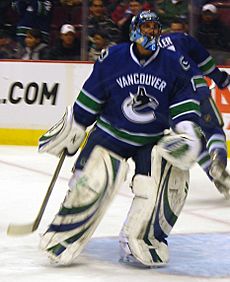
In 2008, Mike Gillis became the new general manager. Roberto Luongo was named team captain, which was unusual for a goaltender. The team also signed veteran star Mats Sundin. The Canucks continued to be a strong team, winning their division in 2009 and 2010.
Back-to-Back Presidents' Trophies and 2011 Final
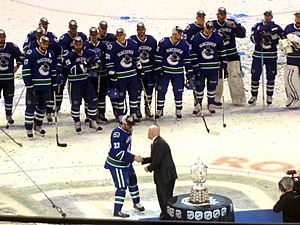
The 2010–11 season was one of the best in Canucks history. Henrik Sedin became the team's new captain. The team finished first overall in the entire league, winning the Presidents' Trophy for the first time. Henrik's brother, Daniel Sedin, won the Art Ross Trophy as the league's top scorer.
In the 2011 playoffs, the Canucks faced the Chicago Blackhawks, who had eliminated them in the previous two years. Vancouver took a 3–0 lead in the series, but Chicago came back to tie it. In a thrilling game seven, Alexandre Burrows scored in overtime to win the series for the Canucks. They then defeated the Nashville Predators and San Jose Sharks to reach the Stanley Cup Final for the third time.
The Canucks faced the Boston Bruins in the Final. The series was a back-and-forth battle, with each team winning their home games. It came down to game seven in Vancouver, but the Bruins won the game and the Stanley Cup. After the game, there were some disturbances in downtown Vancouver, similar to 1994.
The Canucks won the Presidents' Trophy again in 2011–12, but were surprisingly eliminated in the first round of the playoffs by the Los Angeles Kings. The team continued to struggle in the playoffs in the following years.
Recent Years (2014–Present)
In 2014, Jim Benning became the general manager, and Willie Desjardins was named head coach. The team made some changes, bringing in new players like Ryan Miller. They made the playoffs in 2015 but lost in the first round.
The team then went through a rebuilding phase, trading away veteran players to get younger talent. Young stars like Brock Boeser and Elias Pettersson joined the team. Pettersson won the Calder Memorial Trophy as the league's best rookie in 2019.
The 2019–20 season was the Canucks' 50th season. Bo Horvat was named the new captain. The Sedin brothers, Daniel and Henrik, had their jersey numbers retired in a special ceremony. The team made a strong playoff run in the 2020 playoffs, winning two series before being eliminated.
In December 2021, Jim Rutherford became the president of hockey operations, and Patrik Allvin was hired as general manager. Rick Tocchet became the head coach in January 2023. In the 2023 off-season, Quinn Hughes was named the team's new captain, becoming the youngest captain in the NHL.
The 2023–24 season was a great one for the Canucks. They finished third in the Western Conference and won their first Pacific Division title. They won their first playoff series against the Nashville Predators but lost a close second-round series to the Edmonton Oilers. After the season, Rick Tocchet won the Jack Adams Award as the best coach, and Quinn Hughes won the James Norris Memorial Trophy as the league's best defenseman.
Team Information
Home Arenas
The Canucks play their home games at Rogers Arena in downtown Vancouver. This arena opened in 1995 and can hold over 18,000 fans for hockey games. Rogers Arena was also used for ice hockey games during the 2010 Winter Olympics. Before moving to Rogers Arena, the Canucks played at Pacific Coliseum for 25 years.
Logos and Jerseys
The Canucks have had several different logos and jersey designs over the years.
Their first NHL jerseys, used from 1970 to 1978, featured a hockey stick shaped like a "V" inside a blue rink-shaped rectangle. This is known as the "Stick-in-Rink" logo. A modern version of this logo is still used today on their alternate jerseys.
In 1978, they changed to a bold yellow, red-orange, and black "V" design, sometimes called the "Flying V." This look was very different and aimed for a more aggressive image.
The "Flying V" was replaced in 1985 with a logo that had the word "Canucks" slanted diagonally, looking like part of a skate blade. This was often called the "Flying Skate" logo. The team wore yellow home jerseys with this logo for a few years, then switched to white.
In 1997, the Canucks introduced a new logo featuring a Haida-style orca (killer whale) breaking out of ice, forming a "C." The colors were blue, red, and silver.
In 2007, the team changed their jerseys again, keeping the orca design but changing the colors to royal blue and kelly green, which were their original "retro" colors. The word "Vancouver" was also added above the orca on the chest.
For their 40th anniversary in 2010, the Canucks wore special throwback jerseys that looked exactly like their original 1970s uniforms. In 2019, they updated their main uniforms, removing the "Vancouver" script and modifying the "Stick-in-Rink" logo. They also brought back the "Flying Skate" jerseys for special games.
Mascot
The Vancouver Canucks' official mascot is an anthropomorphic killer whale named Fin the Orca. He often bangs a drum or skates around during game breaks, shooting t-shirts into the crowd. Fin is known for playfully "chomping" on fans' heads.
Two fans, known as The Green Men, became unofficial mascots in 2009. They wear skin-tight green bodysuits and are known for their funny antics during games. They even traveled with the team to the 2011 Stanley Cup Final. In 2012, ESPN recognized them in their "Hall of Fans." After a break, The Green Men made surprise appearances again in the 2023–24 season.
Media and Ownership
Canucks games are broadcast on radio and television. Sportsnet holds the television rights, showing regional games on Sportsnet Pacific.
The team has had several owners over the years. Currently, the Vancouver Canucks and Rogers Arena are owned by Canucks Sports & Entertainment, which is headed by Francesco Aquilini and his brothers.
Minor League Teams
The Canucks have minor league teams where younger players develop their skills before potentially joining the NHL team. Their main minor league team is the Abbotsford Canucks in the American Hockey League (AHL). They also have a secondary affiliate, the Kalamazoo Wings in the ECHL.
Season Records
Here's a quick look at the Canucks' performance in recent seasons:
| Season | GP | W | L | OTL | Pts | GF | GA | Finish | Playoffs |
| 2020–21 | 56 | 23 | 29 | 4 | 50 | 151 | 188 | 7th, North | Did not qualify |
| 2021–22 | 82 | 40 | 30 | 12 | 92 | 249 | 236 | 5th, Pacific | Did not qualify |
| 2022–23 | 82 | 38 | 37 | 7 | 83 | 276 | 298 | 6th, Pacific | Did not qualify |
| 2023–24 | 82 | 50 | 23 | 9 | 109 | 279 | 223 | 1st, Pacific | Lost in second round, 3–4 (Oilers) |
| 2024–25 | 82 | 38 | 30 | 14 | 90 | 236 | 253 | 5th, Pacific | Did not qualify |
Players and Staff
Retired Numbers
The Canucks have retired six jersey numbers to honor players who made a huge impact on the team:
| No. | Player | Position | Career | No. retirement |
|---|---|---|---|---|
| 10 | Pavel Bure | RW | 1991–1998 | November 2, 2013 |
| 12 | Stan Smyl | RW | 1978–1991 | November 3, 1991 |
| 16 | Trevor Linden | C/RW | 1988–1998 2001–2008 |
December 17, 2008 |
| 19 | Markus Naslund | LW | 1996–2008 | December 11, 2010 |
| 22 | Daniel Sedin | LW | 2000–2018 | February 12, 2020 |
| 33 | Henrik Sedin | C | 2000–2018 | February 12, 2020 |
The NHL also retired Wayne Gretzky's #99 for all teams.
Numbers Honored
Some numbers have been taken out of circulation to honor players who passed away or had a significant impact:
- 11 – Wayne Maki, a winger who played from 1970–1973. His number was retired after his death in 1974.
- 28 – Luc Bourdon, a defenseman who played from 2006–2008. His number was retired after his death in a motorcycle crash in 2008.
- 37 – Rick Rypien, a center who played from 2005–2011. His number was retired after his death in 2011.
Hall of Famers
Many former Canucks players and team builders have been inducted into the Hockey Hall of Fame.
- Players: Pavel Bure, Igor Larionov, Roberto Luongo, Mark Messier, Alexander Mogilny, Cam Neely, Daniel Sedin, Henrik Sedin, Mats Sundin.
- Builders: Frank Griffiths, Jake Milford, Roger Neilson, Bud Poile, Pat Quinn, Jim Rutherford.
Ring of Honour
The Vancouver Canucks Ring of Honour celebrates important people in the team's history with special displays in the arena.
- Orland Kurtenbach (2010)
- Kirk McLean (2010)
- Thomas Gradin (2011)
- Harold Snepsts (2011)
- Pat Quinn (2014)
- Mattias Ohlund (2016)
- Alex Burrows (2019)
- Roberto Luongo (2023)
Team Captains
There have been 15 captains for the Canucks. The first was Orland Kurtenbach. Stan Smyl and Henrik Sedin were the longest-serving captains, each for eight seasons.
- Orland Kurtenbach, 1970–1974
- Andre Boudrias, 1975–1976
- Chris Oddleifson, 1976–1977
- Don Lever, 1977–1979
- Kevin McCarthy, 1979–1982
- Stan Smyl, 1982–1990
- Dan Quinn, Doug Lidster and Trevor Linden, 1990–1991 (three captains at once)
- Trevor Linden, 1991–1997
- Mark Messier, 1997–2000
- Markus Naslund, 2000–2008
- Roberto Luongo, 2008–2010 (as a goalie, he couldn't wear the "C" on his jersey during games)
- Henrik Sedin, 2010–2018
- Bo Horvat, 2019–2023
- Quinn Hughes, 2023–present
Draft Picks
The Canucks picked Dale Tallon as their first-ever draft pick in 1970. They have had 13 top-five draft picks but have never had the very first pick overall. In 1999, they famously drafted twin brothers Daniel Sedin and Henrik Sedin with the second and third picks.
Head Coaches
The Canucks have had 22 head coaches. Alain Vigneault coached the most games and earned the most points for the team. Rick Tocchet is the current head coach.
Awards and Trophies
NHL Awards
The Canucks and their players have won several important NHL awards:
- Clarence S. Campbell Bowl: 1981–82, 1993–94, 2010–11 (Awarded to the Western Conference playoff champion)
- Presidents' Trophy: 2010–11, 2011–12 (Awarded to the team with the best regular season record)
- Calder Memorial Trophy (Best Rookie): Pavel Bure (1991–92), Elias Pettersson (2018–19)
- Jack Adams Award (Best Coach): Pat Quinn (1991–92), Alain Vigneault (2006–07), Rick Tocchet (2023–24)
- James Norris Memorial Trophy (Best Defenseman): Quinn Hughes (2023–24)
- King Clancy Memorial Trophy (Leadership and Community Service): Trevor Linden (1996–97), Henrik Sedin (2015–16), Daniel Sedin and Henrik Sedin (2017–18)
- Ted Lindsay Award (Most Outstanding Player, voted by players): Markus Naslund (2002–03), Daniel Sedin (2010–11)
- Art Ross Trophy (League's Top Scorer): Henrik Sedin (2009–10), Daniel Sedin (2010–11)
- Hart Memorial Trophy (Most Valuable Player): Henrik Sedin (2009–10)
- William M. Jennings Trophy (Fewest Goals Allowed): Roberto Luongo and Cory Schneider (2010–11)
- Frank J. Selke Trophy (Best Defensive Forward): Ryan Kesler (2010–11)
- NHL General Manager of the Year Award: Mike Gillis (2010–11)
All-Star Teams
Several Canucks players have been named to the NHL's All-Star teams, recognizing them as the best players at their positions.
Team Records
Top Scorers
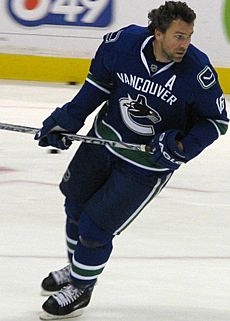
These are the top ten players with the most points in Canucks history:
- * – current Canucks player
|
|
|
Individual Records
Here are some of the top individual records for Canucks players:
Skaters
- Most games played in a career: Henrik Sedin, 1,330 games (2000–2018)
- Most goals in a career: Daniel Sedin, 393 goals (2000–2018)
- Most assists in a career: Henrik Sedin, 830 assists (2000–2018)
- Most points in a career: Henrik Sedin, 1,070 points (2000–2018)
- Most goals in one season: Pavel Bure, 60 goals (1992–93 and 1993–94)
- Most assists in one season: Henrik Sedin, 83 assists (2009–10)
- Most points in one season: Henrik Sedin, 112 points (2009–10)
- Most points in a season by a defenseman: Quinn Hughes, 92 points (2023–24)
- Most points in a season by a rookie: Elias Pettersson, 66 points (2018–19)
Goaltenders
- Most games played in a career by a goaltender: Kirk McLean, 516 games (1987–1997)
- Most wins in a career: Roberto Luongo, 252 wins (2006–2014)
- Most shutouts in a career: Roberto Luongo, 38 shutouts (2006–2014)
- Most wins in one season: Roberto Luongo, 47 wins (2006–07)
- Most shutouts in one season: Roberto Luongo, 9 shutouts (2008–09)
See also
 In Spanish: Vancouver Canucks para niños
In Spanish: Vancouver Canucks para niños



